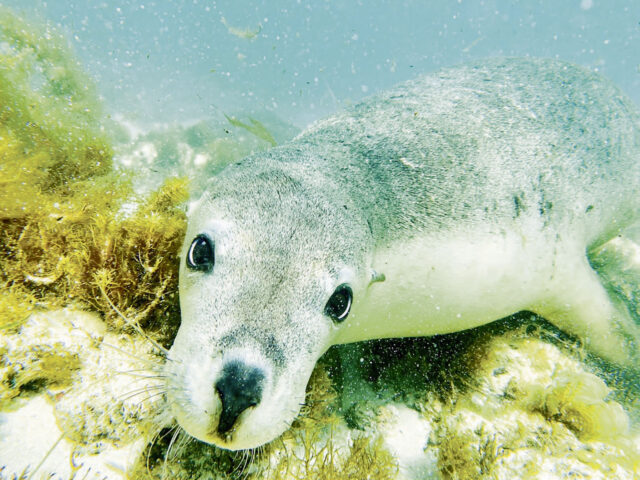
If you thought farming was fickle, try basing your business on the whims of a wily sea lion!
With bellies full of crayfish and octopus, several of these playful pups of the sea can almost always be spotted wallowing on the warm sands of the islands and rock formations in the Jurien Bay Marine Park, part of our beautiful Turquoise Coast.
While an in-the-wild sighting of this endangered species is something visitors from all over the world are happy to pay for, the times that they join snorkellers in a playful game of mimic are truly priceless.
Skipper Kane Krolling saw the opportunity to turn sealion interactions into a tourism business 10 years ago when he started operating fishing charters in the area. Demand saw his business, Turquoise Safaris, grow quickly – and Kane now has three customised catamarans bobbing in the bay, offering sea lion discovery tours 7 days a week, 365 days a year – even in winter!
“We get a lot of European tourists in the winter, and demand is pretty strong all year, says Kane’s partner, Sarah Archer, whose enviable job involves swimming with the sea lions on a regular basis, as well as guiding guests in the water as they snorkel over the teaming coral reef.
“It’s the most amazing experience when the sea lions are playful,” she explains, “if they are in the mood, they’ll mimic, I’ll can just keep twirling and somersaulting in the water and they will copy!”
“Sometimes you’ll have 5 or 6 of them surrounding the boat!” says skipper Corey who admits the job is a bit more relaxing than his previous job as a crayfisherman hauling heavy pots. “It’s amazing when they all come out.”
All the crew are quick to point out that for the sea lions, the interaction is completely on their terms. “We don’t feed them or ‘train’ them,” says Shendelle Hay, who studied as a Marine biologist and is an avid underwater wildlife photographer. “They choose to interact when they want to, and we respect that.”
Observing wildlife in a genuinely real environment has its inherent risks, and in February this year the crew experienced one of their most challenging days when a snorkeller was bitten on the leg by a tiger shark.
“I was actually in the water next to the victim when the attack occurred,” says Sarah.
“It happened so fast and everyone on the day did an above exceptional job. Without the efforts of all the crew that day Sunny (as she’s known) would not be back in her home in Japan. Sunny and I communicate regularly and she is exceeding in her recovery.”
Australian sea lions are among the rarest of the world’s seal species and are listed as endangered since their population numbers are still declining. Sea lions are a major food source for sharks, but their endangered status is more a result of human activity, such as overfishing, climate change and hunting (now illegal).
As Shendelle explains to guests on the tours, the breeding cycle of the sea lion hasn’t helped numbers. “At seventeen months, sea lions have the second longest gestation of any mammal! To make matters even more challenging there’s just a week long window for a female sea lion to get pregnant again after giving birth to her pup. Pups are born cute and black – about the size of a football, but must be taught to swim by their mums, so we don’t see them here out and about until they are about seven months old.”
Jurien Bay Marine Park has the only breeding area for Australian sea lions on the west coast of Australia, and regulations to protect them include a 100 meter distance barrier for vessels and watercraft.
Licensed tour operators are allowed a little closer, but are restricted to just 45 minutes swimming time for snorkellers, and a daily maximum time near the islands.







